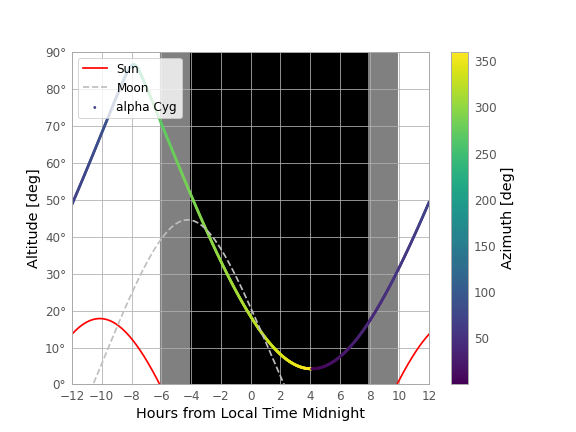Campaign details
This STAROS campaign is dedicated to observing Deneb (alpha Cygni), the brightest star in the Cygnus constellation.
We invite you to take part by using your spectrograph in "high spectral resolution" mode to follow the temporal evolution of the Halpha line, located in the red part of the spectrum.
How long ?
The STAROS Deneb campaign is scheduled over a 3-month period.
Why Deneb ?
It may seem strange to propose an observing campaign on a star as familiar and bright (V=1.65) as Deneb. But more needs to be said. Deneb is a supergiant of spectral type A2Ia. Like all objects of this type, its surface is hot, close to 8400 K, and as the term "supergiant" implies, its radius is 200 times that of the Sun.
Beneath its innocuous, calm appearance in the summer sky, Deneb is in reality an active object when scanned with a spectrograph. Its atmosphere is subject to eruptive phenomena, sometimes very rapid (overnight evolution), sometimes slower (evolution over a few weeks), erratically, a priori. They reflect mass loss and environmental changes. The light emission in the Halpha line (6563 A) is of particular interest here. This activity is the symptom of phenomena that it is essential to decipher in order to understand the physics of these unusually large stars.
Visibility today at Paris

Deneb's brilliance makes it a good laboratory for studying the mechanisms at the surface of supergiants. This brightness has not prevented professional teams of astronomers from studying it. See in particular this page:
Philippe Stee's pageOr this article (to which one of us, C. Buil, contributed) :
Time, spatial, and spectral resolution of the Halpha line-formation region of Deneb and Rigel with the VEGA/CHARA interferometerPro-am collaborations are possible, as here with the Observatoire de la Côte d'Azur, and will be encouraged by the current STAROS campaign.
A few other bibliographical references :
In addition to the scientific objective, this campaign has another very important goal: to validate observing procedures. Following on from the STAROS campaign dedicated to the alpha star Draconis, which focused on spectral calibration accuracy, for Deneb the emphasis is on radiometric calibration accuracy (good continuum, line profile reproducibility...). This is an important step in learning astronomical spectrography. The aim is also to show that you don't have to look for difficult stars to make exciting observations - the sky is very rich and surprising in spectrography, even with unexpected targets.
What to observe with?
The aim is to detect subtle variations in the profile of the Halpha line, which means that high spectral resolution is required to participate. The spectrograph must have a resolving power greater than or equal to R = 12000. Examples of such spectrographs include Shelyak's Lhires III, with a 2400 line/mm grating, and the Star'Ex HR spectrograph.
As for the instrument used, given the brightness, a telescope 60 mm or larger will provide very good data for this campaign. Large telescopes are also quite suitable, but it should be noted that here, small diameters (80 - 150 mm) are rather more advantageous, as the resolving power is then inherently high due to the narrowness of the entrance slit (aiming for R=18000 to R = 22000 may be an objective, but is not essential).
How to observe?
As always, spectra must be carefully calibrated in wavelength (using telluric lines - see the alpha Dra campaign) and instrumental response estimated. A signal-to-noise ratio of 300 or more is desirable (adjust exposure time and number of images accordingly - taking care not to saturate the detector).
If you have the opportunity, do one spectrum per clear night, or even two or three spectra per night, spaced a few hours apart.